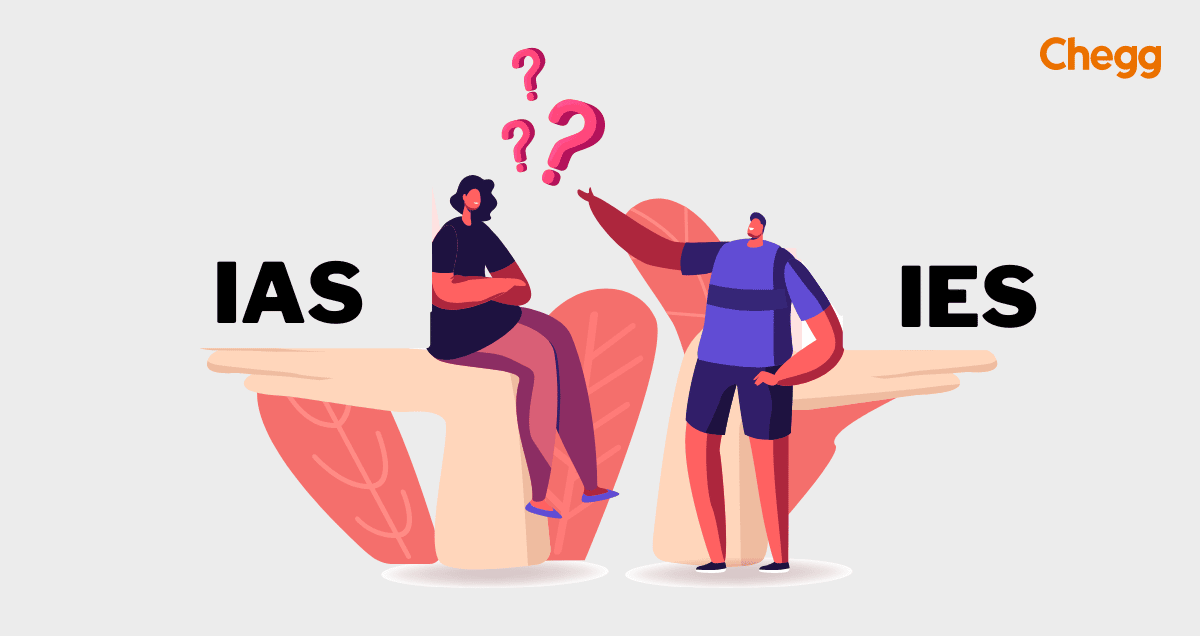

Quick Summary
- IAS and IES are two fundamental units of the central government.
- IAS stands for Indian Administrative Services and IES stands for Indian Engineering Services.
- IAS officers are employed in the public administrative division while IES officers are employed in the technical division for handling technical projects of the Indian government.
Table of Contents
IAS and IES are two units of the Union Government. IES represents Indian Engineering Services, and IAS stands for Indian Administrative Services. The Union Public Service Commission (UPSC) conducts both examinations.
The difference between the two is that IAS officers are employed in the administrative or managerial division of the Indian Government. While the IES officials are delegated to handle the executive and technical works of the Indian Government.
This article will take you through a detailed comparison between the two cadres and provide a vivid picture of the difference between IAS and IES. Before getting more information regarding the difference between IAS and IES, let us look at IAS and IES separately and clearly understand both cadres.
Difference Between IAS and IES – At a Glance
| Criterion | IAS | IES |
| Full Form | Indian Administrative Service | Indian Engineering Service |
| Eligibility | Indian Graduates from any discipline Age – 21 to 32 | Indian Engineering Graduate Age – 21 to 30 |
| Number of Attempts | 6 (For GEN & EWS) | No Limit |
| Exam Structure | Three Stages: Prelims Mains Interview | Three Stages: Prelims Mains Interview |
| Number of Vacancies | 1011 | 247 |
| Syllabus Length | Vast | Confined to Engineering Subjects |
| Profile | Public Administration | Technical Projects |
| Salary | INR 56,100 | INR 55,135 |
Indian Administrative Services (IAS)
The Indian Administrative Service (IAS) is the administrative arm of the All-India authoritative civil service in India. IAS is one of the three branches of the Union Public Service Commission (UPSC), following Indian Police Services (IPS) and Indian Foreign Services (IFS).
IAS is one of the most prestigious designations as being a part of the executive branch, it is the permanent bureaucracy of India. IAS officials own the key and discretionary posts in the Union Government, States, and open division endeavours.
Various government offices assign important functions to IAS officers. Some of them are as follows:
- Functions as Executive Magistrate/Chief Development Official/District Development Commissioner
- Keeps up law and order
- Gathers revenues and plays out its obligations as the court, in income matters
- Administers the implementation of policies of state and central government
- Administers the use of open assets according to standards of budgetary appropriateness
- Deals with the day-to-day exercises of Government, remembering confining and usage of strategy for discussion with the priest accountable for the concerned Ministry
- Partakes in strategy plan and dynamics at different levels like Deputy Secretary, Joint Secretary.
Related Read: Best Tips for Civil Service Aspirants to Crack IAS
Indian Engineering Services (IES)
Indian Engineering Services, abbreviated as IES, is the common administration that meets India’s innovative and administrative elements. Through the IES Examination, the Union Public Service Commission recruits candidates for the technical wing of the government. These bureaucrats administer a huge segment of the public sector economy of a country.
The Indian Engineering Service (ISE) is one of the most competitive examinations and offers various dignified positions in the managerial and technical fields.
Some of the duties or functions that are expected to be undertaken by an IES officer are as follows:
- The designing branch and the administration or division that an IES employee is enlisted in are entirely responsible for their work assignments.
- These official civil servants can move to any association, organization, framework, service, or PSU of the Government of India.
- One is assigned to appointment premises or given a fixed residency for at least five years.
- After this, they are possibly sent back to their parent framework or they can decide to work in the current unit.
Difference Between IAS and IES
The UPSC CSE and ESE are both national-level examinations conducted Government of India to get recruited under diverse government services. However, there are several elements or criterion which helps to conclude the difference between IAS and IES. Let us understand them:
1. Eligibility Criteria
Let us first understand the difference between IAS and IES based on the eligibility criteria for both examinations.
IAS
On the other hand, to apply for IAS, a candidate should graduate. One does not need to graduate in any specific domain like IES. Also, students who have completed any diploma or correspondence course can apply for IAS.
Students should be Indian citizens and in the last year of education to apply for IAS. The age of an IAS applicant should be between 21 and 32 to be eligible for the application.
IES
The essential eligibility to apply for IES is to have a graduation degree in engineering. BTech/BE graduates in their last year of BTech/BE can apply for these posts. Postgraduates from the Science stream with papers in subjects, such as Wireless Communication, Electronics, Radio Physics, and Radio Engineering, can likewise apply for specific posts. The age restrictions range from 21 to 30 years.
2. Recruitment Procedure
Difference between IAS and IES in terms of recruitment:
IAS
To become an IAS, one has to clear the Civil Service Examination conducted by UPSC. The examination consists of three stages – A Preliminary exam, a Mains exam, and a Personal Interview. The Preliminary exam consists of two objective papers.
Paper 2 is the qualifying exam, while the first paper decides the merit. The next step is the mains exam, which consists of 9 papers, of which two are qualifying exams, and the other seven papers decide the merit. One qualifies for a personal interview if one merits it after the main exam.
IES
The process for IES consists of two stages – A written examination and a personal interview. The examination consists of an objective type section covering general studies topics and a subjective type section where students are expected to answer essay-type questions based on a particular engineering field. If a candidate clears this round, they are invited for the personal interview round, and if they clear this round, they are further selected for different departments based on merit.

3. Competition
The difference between IAS and IES is a hot mess. You will confront intense competition from all sides.
IAS
As stated, IAS is the most serious civil service post. Around nine lakhs up-and-comers apply for civil services assessments consistently. Over 4 lakh applicants go to the prelims.
IES
IES is viewed as perhaps the hardest test, thinking about the specialized idea of tests and the pace of acknowledgement. Around 2.5 lakh applicants endeavour for IES tests each year, and just two or three hundred are chosen.
4. Power and Recognition
Difference between IAS and IES in terms of reputation and responsibilities:
IAS
An IAS official is nearer to individuals and also holds command over law requirements and legal procedures. They likewise bolster the law-making body in guaranteeing the best possible working of legislative frameworks. On arriving at higher positions like Cabinet secretary, an IAS official will also be able to impact political choices. As an IAS official, you will also get the opportunity to be accountable for pretty much every major managerial job.
IES
Indeed, even an IES official gets the chance to move around between various units. An IES gets the opportunity to work with ventures that have something to do with innovation. Along these lines, outside the association, an IES official is working, and the individual in question won’t hold a lot of intensity.
Being an open figure or holding political force relations in the public eye is one of the high-end responsibilities. Outside your activity, you will resemble some other typical national residents.
5. Political Intervention
The difference between IAS and IES can be evaluated based on the political intervention made by both these cadres.
IAS
IAS officers are responsible for maintaining and taking care of social issues and administrative tasks. Hence, IAS officers hold more power. But as they say, “with more power comes more responsibility”.
So is the case with IAS officers. IAS officers are answerable to the legislature, and thus their job involves political intervention.
IES
On the other hand, IES mainly deals with technology. But that does not mean that there is no political intervention. IES officials execute their powers under the legislature, but the political intervention is less than an IAS.
6. Salary
The salary difference between IAS and IES does not vary much. Their salary scale and extra advantages are pretty much equivalent.
IAS
The 7th Pay Commission governs the payscale of civil servants. According to it the monthly salary of an IAS officer is INR 56,100.
IES
According to the 7th Pay Commission, an IES officer earns a salary of INR 55,135 per month.
IAS vs IES – Summary
So, what is the difference between IAS and IES? This article caters to solving the queries of people pondering to differentiate between IAS and IES.
The IAS officials manage a general organization while the IES officials get to associate with innovation. Individuals with the zeal to bring forth a change in the country are best suited for the IAS field. People with good leadership skills make it the best for administrative services.
On the other, IES is more inclined toward people who are tech-driven. Individuals who aspire to exhilarate their technological knowledge and implement it to cater to the country’s needs are more opportune for the IES role.
The decision relies upon a person’s latent capacity and professional objectives. Ensure that you contribute time and thought before settling on your ground-breaking choices. We hope this detailed explanation of the difference between IAS and IES has controlled your bits of knowledge and has augmented your points of view.

Frequently Asked Questions
Q1. Who is more powerful IAS or IES officer?
Ans. Both IAS and IES role is one of the respected and dignified official roles in the Indian Government. The authority and responsibilities lying in the hands of both officials are quite equivalent, However, an IAS officer holds more power and recognition than an IES officer. An IAS officer is more generalized to the public and possesses the authority to implement changes in the community.
Q2. Is IES and IAS salary the same?
Ans. Yes, the salary of IES and IAS officers are almost the same. The salary of civil service officers is governed and determined by the 7th Pay Commission. According to the 7th Pay Commission, the salary of an IES officer is INR 55,135 and that of an IAS officer is INR 55,100.
Q3. Can an IES officer become IAS?
Ans. Yes, an IES officer can become an IAS officer. An Indian engineering service officer can take up the Indian Administrative Service examination. There are no specified restrictions for pursuing IAS even after being an IES officer. IES officers who wish to indulge themselves in general organizational management and administrative services can take the IAS exam.
Q4. What is IES Full Form?
IES Full form is Indian Engineering Services. The UPSC conducts an Engineering Services Exam (ESE), a national-level exam, to select candidates for Indian Engineering Services in various government sectors like Power, Telecommunication, PWD, Railways, etc. The chosen individuals are given the title of class 1 officers who work for the Indian government as engineers.
To read more related articles, click here.
Got a question on this topic?